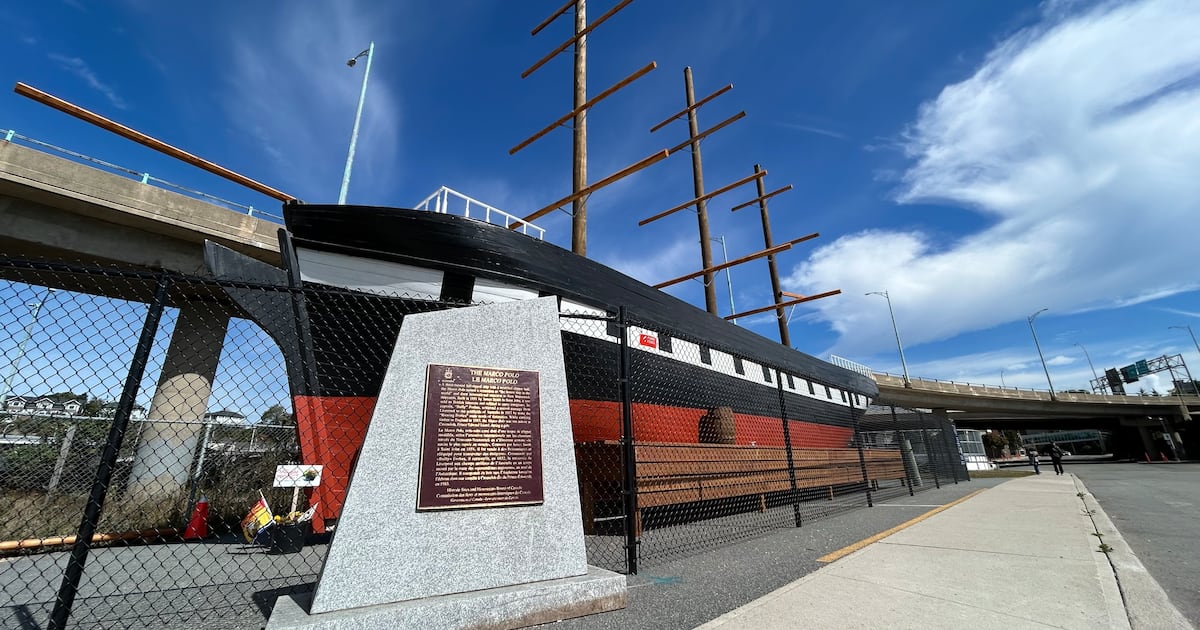Lifestyle
Historic Replica of Marco Polo Returns to Saint John Harbour

A replica of the historic ship Marco Polo has returned to the Saint John Harbour, nearly 175 years after the original vessel set sail from the Bay of Fundy. This one-third scale model now rests at Long Wharf, marking a significant achievement for the local community and its long-standing maritime heritage.
The project was spearheaded by Barry Ogden, a city councillor who has been raising funds to complete the replica for over four decades. According to Ogden, the project has taken immense effort, with total costs reaching approximately $3.1 million when including film and design expenses. “At times it was challenging, but after 40 years we feel really good,” Ogden stated, reflecting on the journey of reconstructing such an iconic vessel.
The original Marco Polo, launched in 1851 by shipbuilder James Smith, was renowned for its speed. It became the first ship to complete a round trip from England to Australia in under six months, earning it the title of the “Fastest Ship in the World.” This achievement solidified its status as a significant part of New Brunswick’s maritime history, with the original ship being recognized as a national historic significant vessel in 1990.
Community Collaboration and Future Goals
The construction of the replica has been a community effort, with various local organizations contributing. Ocean Steel provided support in building the ship’s cradle, while members of the Wolastoqey First Nation assisted with deck cabins. Recently, Saint John Energy helped erect the ship’s masts, demonstrating the collaborative spirit behind the project.
Ogden is still seeking to raise an additional $100,000 to complete remaining elements, such as rigging and lighting. The replica, which had been in storage for several years, finally found its permanent location earlier this summer, much to the delight of local residents.
Reflecting on the importance of this project, Ogden emphasized the need for residents to connect with their city’s rich shipbuilding history. “We built the third largest fleet in the world, and this was the fastest ship in the world,” he noted, highlighting Saint John’s significant contributions during the golden age of sail. He believes that fostering a sense of pride among residents is crucial, especially as the city navigates current challenges.
Historical Significance and Tourist Attraction
Local historian Greg Marquis, a history professor at the University of New Brunswick Saint John and president of the New Brunswick Historical Society, echoed Ogden’s sentiments. He stated that the replica serves as a vital visual reminder of Saint John’s importance in shipbuilding and shipping. “We were way more important than Halifax in the overall picture of things, but a lot of that visual history is gone,” Marquis explained.
He sees the arrival of the Marco Polo replica as a unique opportunity for the province to celebrate its heritage and attract tourists. “This will help with schools and education and just to remind us of our past,” he added, noting the significance of preserving history, especially given the losses incurred from events like the great fire.
While the original Marco Polo never returned to Saint John after its initial departure, it did eventually settle near Cavendish, P.E.I., after a wreck in 1883. The replica now stands as a testament to the storied past of the region and serves as an educational resource for future generations.
As the community embraces this symbol of their maritime legacy, the replica of the Marco Polo not only enhances the waterfront but also rekindles a sense of pride in the rich history of shipbuilding in New Brunswick.
-

 Education3 months ago
Education3 months agoBrandon University’s Failed $5 Million Project Sparks Oversight Review
-

 Science4 months ago
Science4 months agoMicrosoft Confirms U.S. Law Overrules Canadian Data Sovereignty
-

 Lifestyle3 months ago
Lifestyle3 months agoWinnipeg Celebrates Culinary Creativity During Le Burger Week 2025
-

 Health4 months ago
Health4 months agoMontreal’s Groupe Marcelle Leads Canadian Cosmetic Industry Growth
-

 Science4 months ago
Science4 months agoTech Innovator Amandipp Singh Transforms Hiring for Disabled
-

 Technology3 months ago
Technology3 months agoDragon Ball: Sparking! Zero Launching on Switch and Switch 2 This November
-

 Education3 months ago
Education3 months agoRed River College Launches New Programs to Address Industry Needs
-

 Technology4 months ago
Technology4 months agoGoogle Pixel 10 Pro Fold Specs Unveiled Ahead of Launch
-

 Business3 months ago
Business3 months agoRocket Lab Reports Strong Q2 2025 Revenue Growth and Future Plans
-

 Technology2 months ago
Technology2 months agoDiscord Faces Serious Security Breach Affecting Millions
-

 Education3 months ago
Education3 months agoAlberta Teachers’ Strike: Potential Impacts on Students and Families
-

 Science3 months ago
Science3 months agoChina’s Wukong Spacesuit Sets New Standard for AI in Space
-

 Education3 months ago
Education3 months agoNew SĆIȺNEW̱ SṮEȽIṮḴEȽ Elementary Opens in Langford for 2025/2026 Year
-

 Technology4 months ago
Technology4 months agoWorld of Warcraft Players Buzz Over 19-Quest Bee Challenge
-

 Business4 months ago
Business4 months agoNew Estimates Reveal ChatGPT-5 Energy Use Could Soar
-

 Business3 months ago
Business3 months agoDawson City Residents Rally Around Buy Canadian Movement
-

 Technology2 months ago
Technology2 months agoHuawei MatePad 12X Redefines Tablet Experience for Professionals
-

 Business3 months ago
Business3 months agoBNA Brewing to Open New Bowling Alley in Downtown Penticton
-

 Technology4 months ago
Technology4 months agoFuture Entertainment Launches DDoD with Gameplay Trailer Showcase
-

 Technology4 months ago
Technology4 months agoGlobal Launch of Ragnarok M: Classic Set for September 3, 2025
-

 Technology4 months ago
Technology4 months agoInnovative 140W GaN Travel Adapter Combines Power and Convenience
-

 Science4 months ago
Science4 months agoXi Labs Innovates with New AI Operating System Set for 2025 Launch
-

 Technology4 months ago
Technology4 months agoNew IDR01 Smart Ring Offers Advanced Sports Tracking for $169
-

 Top Stories2 months ago
Top Stories2 months agoBlue Jays Shift José Berríos to Bullpen Ahead of Playoffs










